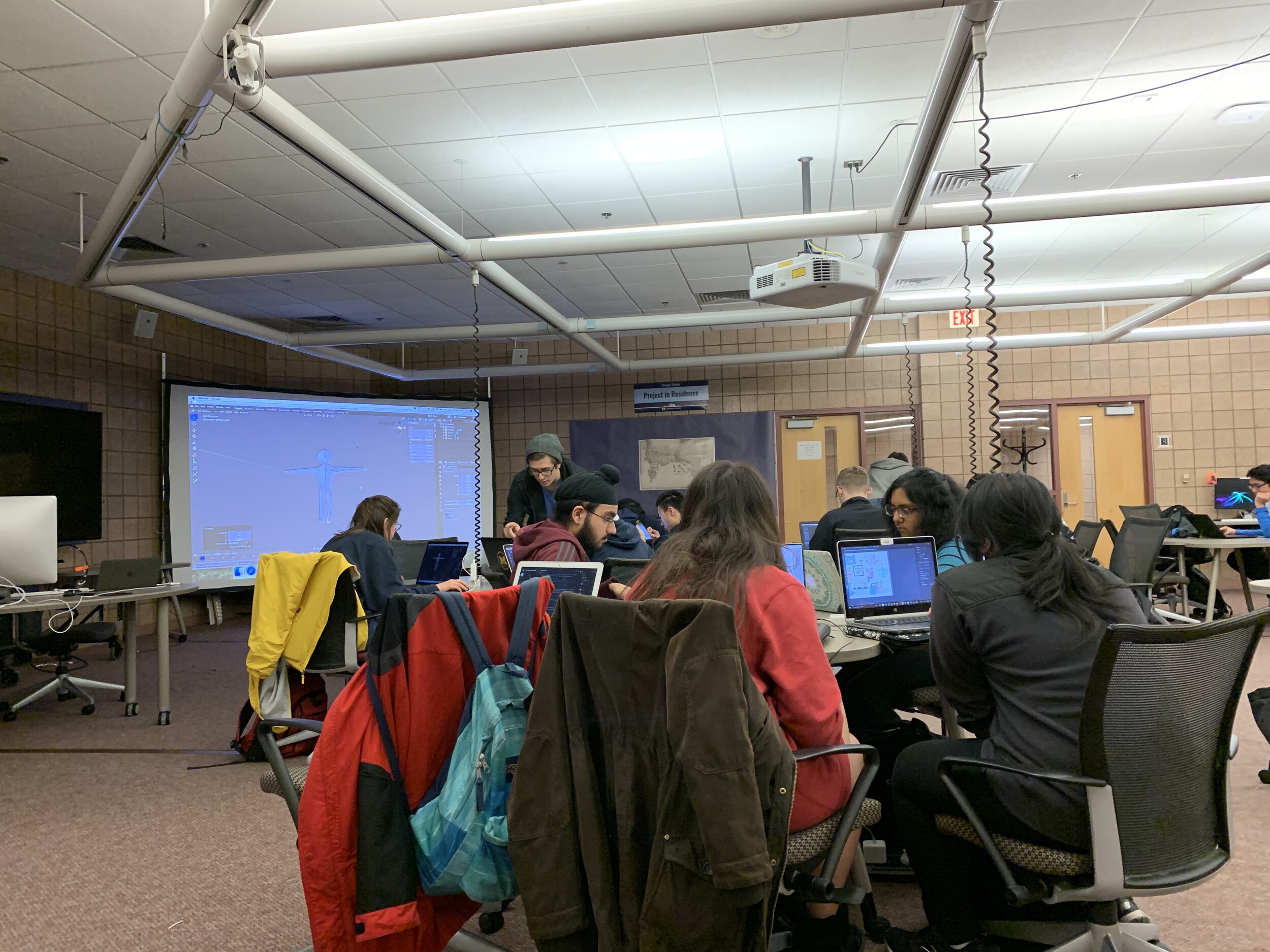
What Is WolverineSoft Studio?
Learn more about the University of Michigan’s non-profit student-run educational games studio.
1 Team. 1 Semester. 1 Game.
Every semester, we search for students who are enthusiastic about games and game development to take on one of the most enriching and exciting student projects the University of Michigan has to offer. Whether you are a complete beginner or professional; an artist, programmer, audio producer, or game designer; a University of Michigan student, or otherwise; we have a huge number of roles that need filling, and a huge number of game ideas that await exploring.
Please read through this page for a detailed overview of what it means to be a part of WolverineSoft Studio for a semester, as well as how you can join the team and even earn academic credits for doing so.
Interested in our past projects?
The Process
Together, members of all disciplines work on the same project through the duration of only one semester. The development cycle, which totals roughly 3 months, is broken into four milestones: the MVP milestone, the Alpha milestone, the Beta milestone, and the Gold milestone. This split is meant to emulate the timelines utilized by most studios in the games industry, large and small. What do those milestones mean?
MVP: The very bare bones point at which the game is playable, and is reminiscent of what it may feel to play the final build. It is at this point that we will be able to sense whether or not the concept of the game works.
Alpha: Feature-lock. The point at which all final core systems and features have been implemented into the game. At this point, the game is able to undergo major testing, as it performs in nearly all the ways it is expected to in its final form. It may be missing all or most of its art, levels, music, etc.
Beta: Content-lock. The point at which all final core content has been added into the game. At this point, no new content will be created, and asides from bug fixes, fine-tuning, and polish, the game is effectively finished.
Gold: The point at which all or most bugs have been fixed, all content has been fine-tuned and “perfected”, an no new changes will be made. The game is ready for release.
These milestones are further broken into 2-week sprints, reminiscent of an Agile workflow. During each of these two week sprints, student leads of the project assign members tasks to complete that will bring the game closer to it’s final goal. Each sprint has a title, and in our case, it is typically in the form “Pre-[X] [#]”. For example, being in Pre-Beta II would be our second sprint in preparation for the Beta milestone.
The studio meets every week, typically on Sundays, for 1-2 hours. During these meetings, the studio director goes over general project updates and announcements. Afterwards, each departments meets, goes over tasks, discusses department-specific topics, etc. With all this, in only approximately 14 weeks, the studio creates a full-fledged game from scratch.
Seven Main Departments
WolverineSoft Studio members apply to join a few different departments. Within these departments, members work together throughout a semester to ensure that a certain aspect of the game is complete and effective, emulating the experience that employees in the games industry might have. Members of each department also meet extensively with members of other departments, earning the Studio its multidisciplinary title. These departments are art, programming, game design, audio, production, marketing and quality assurance. Find out more about each of these departments below!
Programming
Programmers in WolverineSoft Studio write and debug a multitude of scripts in Unity C# (or, on Occasion, Unreal C++) to create engaging and effective gameplay. Oftentimes, this means jumping into a project with scripts written by other programmers, as well as joining calls with other programmers to troubleshoot and problem solve.
Audio
Members of the audio department in WolverineSoft Studio create original sound effects and compose original music to play at certain points in the game project. WolverineSoft Studio uses industry standard software such as Wwise to integrate these sound effects into our Unity projects.
Marketing
Members of the marketing department document the progress of the studio via social media posts. Whether it is featuring concept art or studio members, it is a way to display the evoution and progress of the studio’s many game projects. They also look into applying for grants as well as showcases such as SGDA.
Quality Assurance
Quality Assurance team members aren’t just expert coders, they are also keen gamers with a deep understanding of what makes games fun. QA members work to eliminate our games bugs, ensure proper implementation of designs and assets, and act as the voice of the player to bring studio attention to key issues.
Art
Artists in WolverineSoft Studio create art assets, from concept art, environment art and tile sets, character sprites, animations, to VFX, user interface designs, and post-processing effects. Depending on the project, these art assets may be 2D or 3D. Artists iterate on their work based on feedback from other departments throughout the semester.
Design
Game designers in WolverineSoft Studio do research on game mechanics and create documentation to help guide programmers, artists, and audio members as they create assets and implementations. Designers are responsible for the core ideas and concepts behind each game, as well as for playtesting sessions.
Production
Members of the production department coordinate the efforts of the entire studio, working across departments to ensure on-time delivery of features. Producers also evaluate scope/risk, develop new processes, facilitate meetings and come up with best practices to promote a healthy work environment within the studio.
Earn Academic Credits
Members of WolverineSoft have the opportunity to (and are heavily encouraged to) earn academic credits for participation in WolverineSoft Studio for a semester. It’s as simple as indicating interest, getting approved, and receiving an override in WolverineAccess for ENGRx55, the general MDP course. If you’re going to be putting in the time for a student org, might as well earn academic credits for it. Interested? Find out more below!
What kind of academic credit can I get?
If a student is in EECS, then ENGR 355 and ENGR 455 can count towards your Flex Tech requirements under the "Independent Study" category. Note that most departments have a limit on how many flex tech credits a student can receive (in total) from independent study courses. Once this limit is reached, all remaining credits will count towards general electives.
For students who are not in EECS, and for all students taking ENGR 255, the MDP course counts towards your general elective requirements.
How many credits can I take it for?
Although ENGR 255 and ENGR 355 can technically be taken for 1 credit, WolverineSoft Studio generally does not admit students who only intend to take the MDP course for 1 credit. This is because 1 credit would entail 3 hours of work per week which, after factoring in studio meetings, is not a sufficient amount for a student to be able to meaningfully contribute to their project. We recommend that students instead contribute to the studio without taking it for 1 credit that semester, and look into taking it for more credits in future semesters.
Some exceptions can be made for a student to take the studio for 1 credit. The most common situation for this exception is that a student only has room for 1 additional credit for the semester. In these cases, the student will likely be expected to contribute more than 3 hours per week, and they will also have to speak with the current studio director, before applying to enroll to prove that they will have the availability and dedication to meaningfully contribute to the studio despite their heavy workload.
The potential range of credits a student can earn from ENGR x55 in a single semester is dependent on which x55 course the student is enrolled in.
Above, you may find the amount of credits you may enroll for at each level of ENGR x55. Students may elect to take any amount of credits within that range.
Which course level do I qualify to take?
Your class standing (freshman, sophomore, junior, senior) and major/school do NOT influence which course level you qualify for.
Any student qualifies to take ENGR 255
A student's MDP course level is based on previous / currently enrolled courses. A student who has completed a 300-level course in their major, OR who is currently enrolled in 2 or more 300-level courses in their major would qualify for ENGR 355. The same rule applies for leveling up to ENGR 455.
How do I enroll in the course?
When applying for membership in the studio, indicate that you would like to take the course for MDP academic credits, and indicate how many credits you would like to take the studio for. These are all pre-made options in the application form itself.
If you are accepted into the studio, the studio director will reach out to you to verify your request, as well as to verify that you have the availability to commit as many hours as you initially requested.
Once verifying that information, the studio director will submit an override request for you to the MDP office, requiring approval from the MDP program coordinator (currently Megan Langille) and the MDP course adviser (Austin Yarger). This request is normally accepted within 2-3 business days.
Once the override request is accepted, the MDP program coordinator will send you an email with your approved override request and instructions on how to enroll in the course on WolverineAccess.
What is the workload?
Students are expected to work 3 hours per week for each credit hour they are enrolled in the studio for. This expectation is enforced and measured based on the tasks that a student is assigned, which are each given a time-tracking metric to ensure a student is given an appropriate amount of work.
How is grading determined?
It’s very simple! Every 2 weeks, students are expected to create a short blog post on a personal website that details all the work they’ve done in the previous 2 weeks. This blog post may include screenshots, text, videos, etc. that showcase the amount of work done, as well as the thought processes that went into this work. So long as the student completes all of these blog posts sufficiently, on time, and in a way that proves they have done as much work as they signed up for, they will earn an A+ in the course.
More information on how these blog posts are structured will come as students are accepted into the studio. Creating these blog posts should not take more than 2 hours per 2 weeks of work, and having these blog posts to show off are expected to help students explain their project experience to friends and recruiters in the future.
Can I take the course multiple times?
Each level of the MDP course (255, 355, 455) can be taken up to three times.
Interested?
Questions About the Studio?
Email us any time at wsoft.studio@umich.edu








